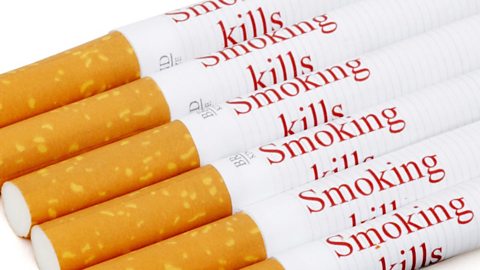Can stamping 'smoking kills' on cigarettes help more people quit?
A suggests that health warnings printed on individual cigarettes could make a significant difference in reducing smoking.
Ninety-one countries around the world, covering 52% of the world's population, now command strong graphic warnings be placed on cigarette packaging. But should we go a step further and insist on "smoking kills" warnings on the cigarettes themselves?
Dr Crawford Moodie from the University of Stirling's Institute of Social Marketing spoke to Good Morning Scotland.
What did smokers make of the idea?

Should individual cigarettes be branded with "smoking kills" message?
According to expert new research suggests it could make a significant difference.
"We asked 120 smokers about packaging more broadly and we showed them a number of cigarettes with warnings on them really just to gauge their views."
"In every group warnings on cigarettes were considered to have a potential impact on themselves, others, or both", says Dr Moodie.

Avoidance behaviours
"In the UK our standardised cigarette packaging has large pictorial warnings on both sides of the pack but some smokers do engage in avoidance behaviours", says Dr Moodie.
"They try and hide these [warnings] and people mentioned within this group that warnings on the cigarettes themselves would make avoidance behaviour more difficult."
The smokers asked said they believed that written warnings on the side of the cigarette would prolong the health message.
"The message would be visible when it's taken from the pack, when it's lit, when its in the ashtray, with each draw."

Off-putting
Dr Moodie points out, "the visibility wouldn't just be to the smoker but to other people as well. That was off-putting for some and for some young women in particular they thought it would create quite a negative image."
Although in Scotland this idea has not been introduced as a policy measure, in May last year the Scottish Government included it as a possible policy option within their latest tobacco control action plan.
The Canadian government has also consulted on it.

Do warnings make a difference?
A study, funded by Cancer Research UK and published in the journal Jama Network Open, found average cigarette consumption fell by nearly a quarter between 2011 and 2018. Approximately 118m fewer cigarettes are smoked each month.
According to the researchers suggested the decline in consumption was "encouraged by stricter laws on marketing and advertising of tobacco, designed to encourage people to quit smoking."

Should other unhealthy products have graphic warnings?
In the last decade many other unhealthy habits have been compared with the dangers of smoking. Should these products also potentially be labelled with health warnings?
Bacon butties - A 2016 ±«Óãtv programme said that the cancer risk associated with eating bacon has been calculated to be the equivalent of four cigarettes in terms of shortening life expectancy.
Office chairs - A 2012 study suggested a lack of exercise is causing as many deaths as smoking across the world.
Fizzy drinks - It's 2019 and sugary drinks are already taxed - and now a leading think tank has even suggested sweets, snacks and sugary drinks should be wrapped in plain packaging to make them less appealing.
Latest features from ±«Óãtv Scotland
-
![]()
'Wild swimming helps me process the grief of losing my son'
The benefits of cold water therapy.
-
![]()
Winter adventures are appealing, but an expert advises caution
Trips in winter require particular knowledge and skills.
-
![]()
The rescuers: Why volunteers risk their lives in mountain emergencies
Landward meets members of the Cairngorm Mountain Rescue Team.
-
![]()
‘Look for the light’ – practical tips to help you through another winter with SAD
Useful advice and tips to combat low moods at this time of year.
-
![]()
How you could be a binge drinker without even knowing
Binge drinking is classed as fewer units than many people may realise.
-
![]()
How chocolate biscuits and drama classes helped one man leave prison behind
The healing power of creativity.
-
![]()
'When people believe in you, it’s life-changing'
Author Graeme Armstrong revisits the man who helped turn his life around.
-
![]()
The 'breath-taking' display of US birds swept on to British soil
Recent storms have brought rare birds to our shores.
-
![]()
Six things we learned about Alan Cumming on Take the Floor (Spoiler: includes accordions)
The actor spoke to Take the Floor's Gary Innes.
-
![]()
How street gangs trap young men in a dangerous cycle of violence
The almost inescapable pull of life in a gang.
-
![]()
Why stylist Gok Wan believes there's no such thing as bad fashion
The fashion expert says we should stop following rules and do what feels right.
-
![]()
Is sending a CV still the right way to apply for a job?
They've been central to job applications for years, but are they worth it?















